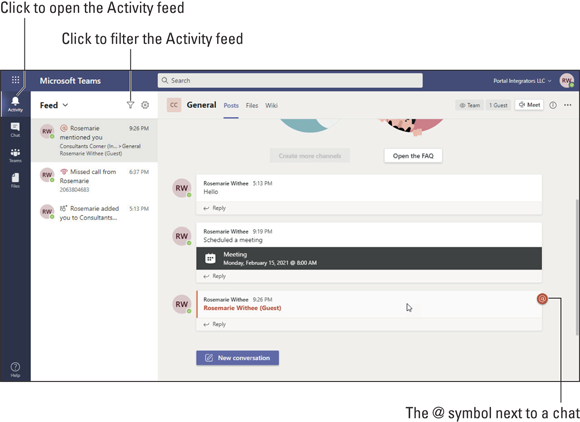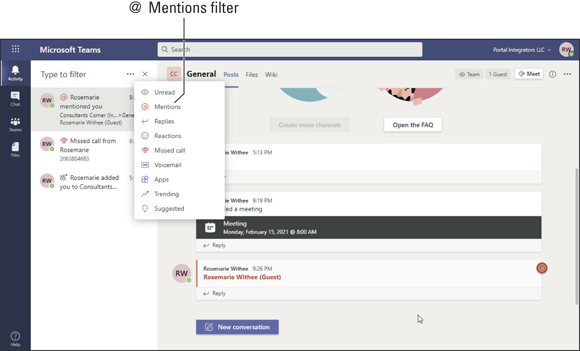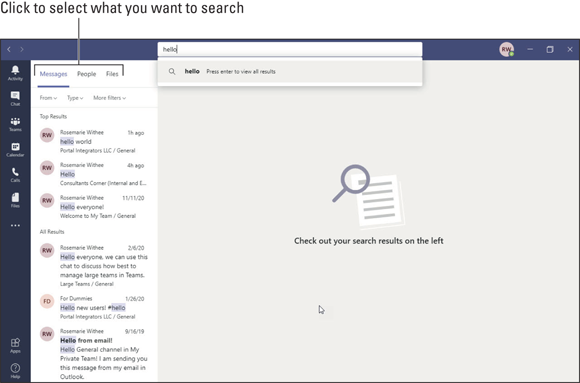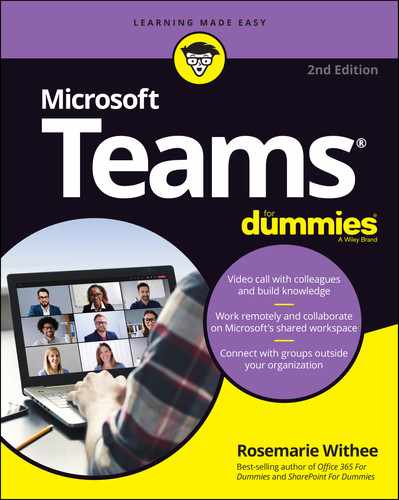Chapter 8
Taming the Noise and Staying Focused
IN THIS CHAPTER
![]() Reducing noise in Teams
Reducing noise in Teams
![]() Taking control of too many channels
Taking control of too many channels
![]() Searching and filtering teams and channels
Searching and filtering teams and channels
![]() Making searching easier with hastags
Making searching easier with hastags
When I work with organizations to adopt Microsoft Teams, I usually make the same observation: There seems to be a point when an organization goes from having a few people using Teams here and there, to everyone using Teams for all communication. When this happens, Teams becomes very noisy very fast! This is more evident as more and more people are doing work remotely and online these days. Luckily, some of the features of Teams have been designed specifically to help you get a handle on all this activity.
In this chapter, you find out how to use Teams to focus on the communication that matters to you and ignore the rest. More than ever, it is good to feel some control when even your conversations on Teams can be chaotic. You learn how to set the Activity feed to filter conversations and set up notifications for the topics important to you. I also share some of the tips I have learned over the years that help me stay focused yet be available for critically important communications.
Embracing the Activity Feed
The Activity feed is a one-stop shop for all things that are happening in Teams. I have heard Microsoft describe the Activity feed as your “inbox for Teams,” and I agree. I tend to start my workday by looking at the Activity feed just like I used to start my day by looking at my email inbox.
To view your Teams Activity feed, select the Activity icon in the left navigation pane, as shown in Figure 8-1.

FIGURE 8-1: Viewing the Activity feed in Teams.
The Activity feed lists the activities that happen in Teams that you might want to pay attention to. For example, you will see the activity in the teams and channels you are following, private chats, locations where people @mention you, replies to your chats or chats you have liked, calls you have received, voicemails, and notifications from apps. You will also see activity such as someone adding you to a channel or team, chats that are trending, and chats that Teams thinks you might want to check out.
The Activity feed includes a filter option to limit the types of activity you see in the feed. For example, suppose you want to only pay attention to when someone has @mentioned you. You can click the Filter icon (refer to Figure 8-1) and then select the @ Mentions filter, as shown in Figure 8-2.

FIGURE 8-2: Filtering the Activity feed to only show @mentions.
Hiding and Showing Teams and Channels
The concept of a team in Teams is a grouping of people. And any person can be in multiple teams. You might be in a team that is putting together a fund-raising event, while at the same time be in your working team in finance, be part of another team that is working on a special project, be in a team that involves everyone in the company, be in a team for people who like cats, and so on.
The number of teams you can be in is only limited by people’s imaginations. As Teams becomes popular in your organization, you will likely be in more teams that you ever thought possible. In addition, as you read in Chapter 4, each team can contain multiple channels. When you combine the multitude of teams you are in with the multitude of channels in each team, you can quickly see how the information can get out of control.
Fortunately, you can show or hide certain teams and channels to reduce the number of teams that show up in your navigation. To hide a team, click the ellipsis next to the name of the team and select Hide from the More Options drop-down menu, as shown in Figure 8-3. To hide a channel, you do the same thing, but click the ellipsis next to the channel you want to hide.

FIGURE 8-3: Hiding a team from the list.
When you hide a team, it moves to a collapsed section in your list of teams. When you hide a channel, it moves to a section at the bottom of the channels in a team.
When you click “Hidden Teams” or “Hidden Channels,” the list expands to show the teams or channels you have hidden. To unhide a team, click the ellipsis next to the hidden team and select Show from the More Options drop-down menu. To unhide a channel, click Hidden channel, and then in the fly-out menu that shows all of the hidden channels, click Show next to the channel you want to see (see Figure 8-4).

FIGURE 8-4: Showing a hidden channel.
Filtering by Team or Channel
As you discovered in the previous section, you can hide and show teams and channels. Even with this ability, you may also want to filter the list of teams and channels to find one in particular you are looking for. This might sound crazy until you find yourself with over a hundred teams and thousands of channels. I never realized how many teams and channels were possible until I found myself searching for a channel I know exists but cannot find in the list.
To filter the list of teams and channels, click the funnel icon at the top of the teams list, and then type in a word to filter by the name of the team or channel. In Figure 8-5 I am filtering my list of teams by the word “private.”

FIGURE 8-5: Filtering the list of teams and channels.
Changing the Order of Teams in Your List
In general, people scan through their teams and channels from the top to the bottom. As such, you might find it helpful to keep the most important teams at the top of the list so that you spot them first. You can drag and drop teams in your list to change the order. To do this, just click and hold a team name and then drag and drop it at the location you want to move it, as shown in Figure 8-6.
Muting Channels to Decrease Notifications
You can mute a channel to stop notifications from appearing in your Activity feed if you find yourself bombarded with the constant pinging of new messages. You can still click on a channel that is muted and follow along with the conversation; however, muting it makes the process more proactive — you decide when to pay attention to and/or respond to notifications. For example, I usually mute channels that I like to keep track of but don’t need to respond to frequently. Then, when I have time, I click through the channels to keep up with those conversations.

FIGURE 8-6: Drag and drop teams in your list to change the order.
To mute a channel, follow these steps:
- Click the ellipsis next to the channel name you want to mute.
Select Channel Notifications from the drop-down menu that appears.
The Channel Notifications Settings dialog box appears, where you can adjust the settings to be notified for All Activity, turn off notifications, and set custom settings.
Select Off to mute the channel.
You will not be notified of new activity, except if someone directly replies to you or mentions you in a message.
Tracking Important Activity with Custom Notifications
Even with all the features you have seen thus far in the chapter, the amount of information coming at you can quickly become overwhelming. One of the most important features you can use to sift through the mountain of chatter is the custom Teams notifications settings, where you can set how often you receive notifications of new activity in your channels.
To access the custom notifications settings, click the ellipsis next to the channel you want to adjust, select Channel Notifications, and then select Custom. Two settings appear in the Channel Notification Settings dialog box:
- All new posts: This setting enables you to adjust your notifications for any new message posts (also known as new message threads), in a channel.
- Channel mentions: This setting enables you to designate when and how you are notified when someone @mentions you in a channel.
You can choose three options for each setting. You can choose to turn off notifications completely, show notifications only in your Activity feed, or show notifications in your Activity feed and also in the Teams banner that pops up at the bottom of your computer screen (similar to when you get a new email and are notified about it).
Searching for Past Conversations
One problem I always seem to have is that I remember having a conversation, but I may not always remember the specific details such as dates, times, locations, and conclusions. If I don’t write it down when I am having the conversation, then I will likely not remember it down the road. The nice thing with digital communications is that there is a record of the conversation (assuming the conversation was held in chat and not voice). Using the search functionality of Teams, you can search through all the digital conversations that have happened to jump right to the conversation you want to remember.
The search functionality takes the shape of a search box. You find the search box at the very top of the Teams application, as shown in Figure 8-7.

FIGURE 8-7: Using the search functionality in Teams.
When searching Teams, you can search for more than just digital communications. You can also search for people who are part of the teams in your organization, and you can even search for files. Click the appropriate tab at the top of the left navigation pane to change between the results (refer to Figure 8-7).
Getting Creative with Search and Hashtags
If you have used Twitter or Slack or Yammer, then you are probably familiar with the concept of a hashtag. A hashtag is comprised of the pound symbol (#) immediately followed by a series of characters or words. For example, #CompanyPicnic is a hashtag.
On Twitter you could click this hashtag and see any tweet that someone sent that includes this tag. In other words, a hashtag is a way to add keywords to a message in order to group it with other similar messages.
As of this writing, Teams doesn’t include the functionality of hashtags. However, I use the concept of hashtags all the time in Teams. The way I like to use hashtags is to tie topics of conversation or concepts together by adding a hashtag to them. Then I can easily type the hashtag in the search bar and see all areas throughout Teams where I have added the hashtag. I use this within wikis, OneNote files, channels, and private chats.

 Each notification in the Activity feed includes an icon that describes the type of notification. For example, notice the @ (“at”) symbol in
Each notification in the Activity feed includes an icon that describes the type of notification. For example, notice the @ (“at”) symbol in